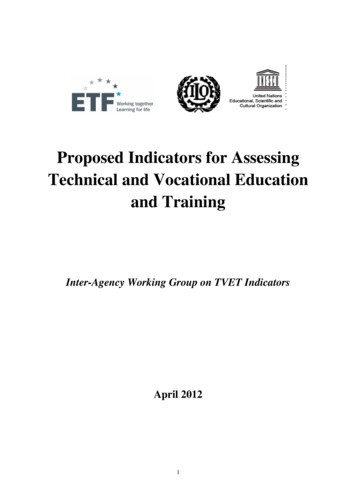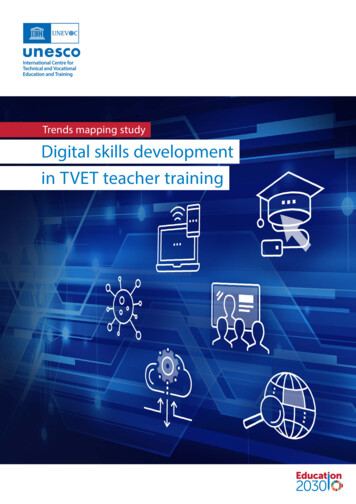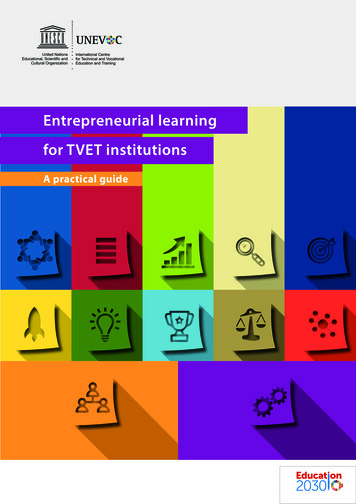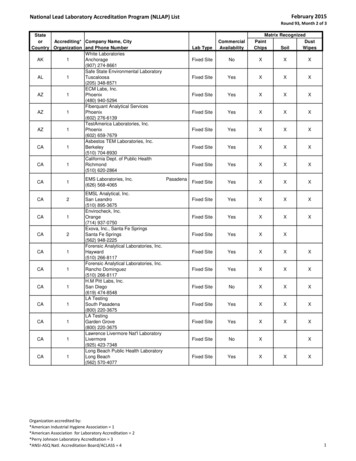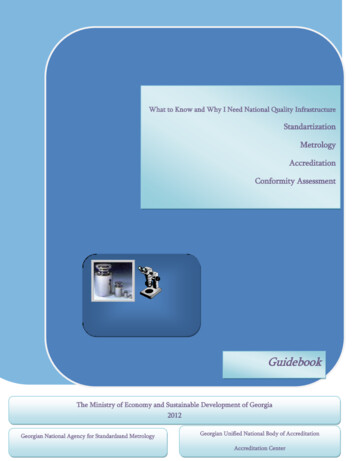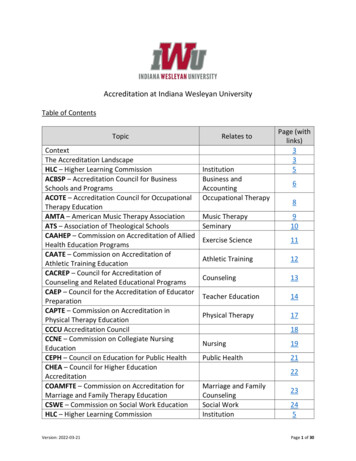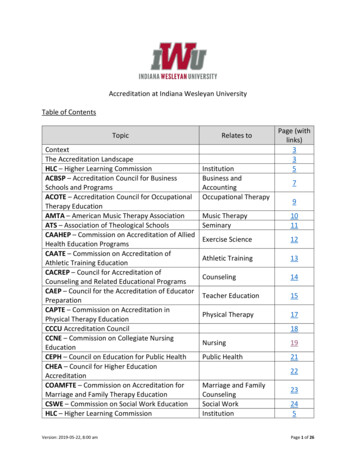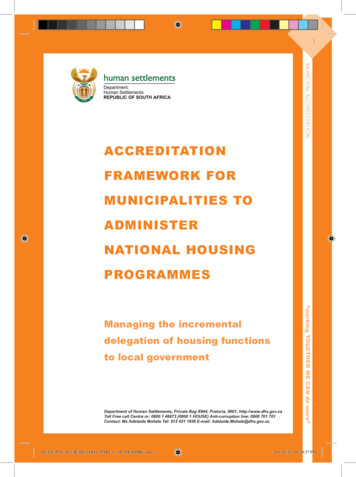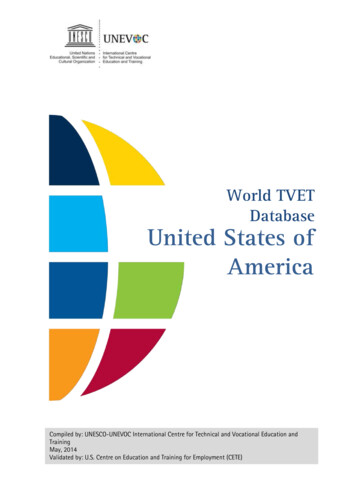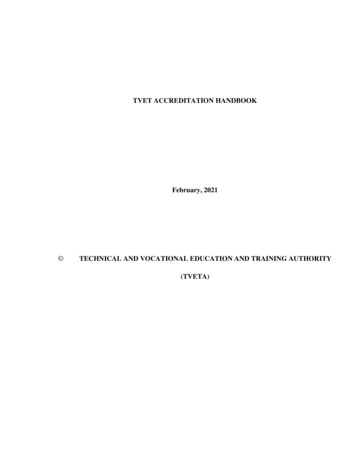
Transcription
TVET ACCREDITATION HANDBOOKFebruary, 2021 TECHNICAL AND VOCATIONAL EDUCATION AND TRAINING AUTHORITY(TVETA)
TVET Accreditation Handbook 2021A.FOREWORDTechnical and Vocational Education and Training Authority (TVETA) is a state corporateestablished by the TVET Act No.29 of 2013. Its mandate is to regulate and coordinate the TVETsector through accreditation of institutions, programmes, trainers as well as assure access, quality,equity and relevance in education and training.One of the most important features of TVET is orientation towards the world of work andacquisition of relevant skills. TVET institutions are well placed to train the skilled andentrepreneurial workforce that Kenya needs to implement the Big Four Agenda, create wealth andattain Vision 2030. However, the sector still has challenges in delivering quality and relevanttraining. These challenges include issuance of internal certificates, use of unqualified trainers,inferior infrastructure that cannot support CBET training.To mitigate these challenges, TVETA as a regulator has developed standards and regulations thatwill regulate the TVET sector and guarantee minimum provision for quality education andtraining. This is anchored in the TVET Act, 2013 that mandates TVETA to provide policies thatgovern establishment and accreditation of training institutions, programmes and trainers.This handbook therefore seeks to provide guidance to Institutions seeking to be accredited. It is aone-stop-shop, that provides all the necessary information and guides the user through a seamlessaccreditation process.2
B.ACKNOWLEDGEMENTDr Kipkirui Lang’atDirector General/CEOiii
TVET Accreditation Handbook 2021C.ABBREVIATIONS AND ACRONYMSBODBoard of DirectorsBOGBoard of GovernorsCBETACompetence- Based Education, Training and AssessmentDTAQADirectorate of Technical Accreditation and Quality AssuranceKASNEBKenya Accountants and Secretaries National Examinations BoardKNECKenya National Examinations CouncilTVETTechnical and Vocational Education and Training“establish, promote, maintain and improve standards of training through accreditation and quality assurance of TVET2 Page
TVET Accreditation Handbook 2021D.DEFINITION OF TERMSAccreditation: The process whereby a nationally recognized agency or organization grants publicrecognition to a unit of an educational organization (such as a school, institute, college, university, orspecialized program of study) indicating that it meets established standards of quality.Course: A programme of instruction comprising a range of syllabus content areas that aspiring traineesundergo to acquire knowledge, work attitudes, skills and competences for employment in formal orinformal sectors.Curriculum: A programme of courses fulfilling the requirements for a certificate, diploma, or degree ina particular field of study.Diploma: An academic designation awarded for the completion of a specified program of study which isof shorter duration than a degree and longer duration than a certificate. A diploma is awarded forprogrammes varying in length from one year to three years.Distance Learning is any learning in which the trainer and the trainee are separated by time or space orboth. It can be synchronous (instruction delivered and received simultaneously), or it may beasynchronous (instruction delivered and received at different times). Trainees may learn privately ormay learn in groups.Electronic Learning or E-Learning is an approach to learning in which content is delivered viaelectronic means such as through the use of the internet, intranet/extranet, audio or video CDs/DVDsand Mobile Phones.Full Registration: an accreditation status conferred to an institution once the Minister is satisfied thatefficient and suitable instruction is being provided. This is usually accorded after Provisional registrationthat is valid for maximum of 18 months.Industrial Attachment: A supervised practical experience that is the application of previously studiedtheory under the supervision of a member of teaching staff and a supervisor in the Industry.“establish, promote, maintain and improve standards of training through accreditation and quality assurance of TVET3 Page
TVET Accreditation Handbook 2021Manager: A person having a contractual relationship to provide management services to a TVETinstitution.Ministry: This is the Ministry responsible for TVET programmes.Open Learning is an approach to learning that gives trainees flexibility and choice over when, at whatpace, where, and how they learn. Open learning emphasizes giving learner choices about: media, whether print or electronic; place of study, whether at home, in the workplace or on campus; pace of study, whether closely paced or unstructured; support mechanisms, whether training staff on demand or computer-assisted learning; and entry and exit pointsProgramme: A sequential grouping of courses which forms a considerable part, or all, of therequirements for an academic credential or an occupational objective.Provisional Registration: the initial accreditation status conferred upon an institution by the Ministervalid for a period of eighteen (18) months.Quality Assurance: consists of procedures, processes and systems used to guarantee and continuouslyimprove the training standards of a TVET institution. Quality assurance is carried out using jointlydefined, operation-enhancing and appropriate procedures, methods and tools.Standards: It is an established norm or requirement.TVET Institution: An institution offering Technical and Vocation Education and Training. TVETProgrammes: Programmes offered by a TVET institution.“establish, promote, maintain and improve standards of training through accreditation and quality assurance of TVET4 Page
TVET Accreditation Handbook 2021TABLE OF CONTENTSa.FOREWORD . 2b.ACKNOWLEDGEMENT . 1c.ABBREVIATIONS AND ACRONYMS. 2d.DEFINITION OF TERMS . 3e.LIST OF TABLES . 9CHAPTER 1:OVERVIEW OF TVETA. 101.1PREAMBLE . 101.2VISION AND MISSION . 111.2.1VISION . 111.2.2MISSION . 111.3FUNCTIONS OF TVETA . 111.4ACCREDITATION AND QUALITY ASSURANCE . 131.5BENEFITS OF ACCREDITATION TO STAKEHOLDERS . 131.6PURPOSE OF THE HANDBOOK . 14CHAPTER 2:CRITERIA FOR ACCREDITATION OF TVET INSTITUTIONS . 152.1PRELIMINARY . 152.2LEADERSHIP AND MANAGEMENT . 152.2.1LEADERSHIP . 152.2.1.1THE COUNCIL AND BOARD OF GOVERNORS. 152.2.1.1.1THE COUNCIL . 152.2.1.1.2THE BOARD OF GOVERNORS . 152.2.2THE MANAGEMENT . 162.2.2.1THE MANAGER/PRINCIPAL . 172.2.2.2DEPUTY PRINCIPAL. 192.2.2.3REGISTRAR . 192.2.2.4Dean of trainees:. 202.2.2.5Examination/ Assessment Office . 202.2.2.6Industrial Liaison Office (ILO) . 202.2.2.7Guidance and counselling . 212.2.2.8Internal Quality Assurance (IQA) . 222.32.3.1LEGAL AND ADMINISTRATIVE DOCUMENTS: . 22Strategic plan: . 24“establish, promote, maintain and improve standards of training through accreditation and quality assurance of TVET5 Page
TVET Accreditation Handbook 20212.4ADMISSION REQUIREMENTS . 242.5CURRICULUM . 252.6Examination and Assessment Process . 262.7STAFFING . 272.8UTILITY SERVICES: . 282.8.1Water . 282.8.1.1Quality of water supplied should:. 282.8.2Waste disposal . 292.8.3Surface Run-off Water Collection and Disposal . 292.8.4Source of power . 302.8.5Surrounding environment . 302.9TRAINEE’S WELFARE . 302.9.1Guidance and Counselling. 312.9.2Persons living with disabilities (PLWDs) . 312.10Religious observance . 312.11Gender equality and inclusivity in Education. 322.12Co - curricular Activities . 322.13Code of conduct for trainees . 322.14OPEN, DISTANCE AND E- LEARNING (ODeL) . 332.14.12.15trainee Orientation on ODeL . 33PHYSICAL FACILITIES . 342.15.1Physical Resources . 342.15.2Facilities . 342.16Surrounding Environment . 352.17Accessibility . 352.18Land Requirements . 362.19Land Master Plan . 362.20Conformance to Statutory Requirements . 372.21Safety of Facilities . 372.22Public Safety . 382.23Access by Persons Living with Disability . 382.24Fire Safety . 382.25Public Health . 392.26Theory Rooms and Offices. 402.26.1Theory rooms . 40“establish, promote, maintain and improve standards of training through accreditation and quality assurance of TVET6 Page
TVET Accreditation Handbook 20212.27Staff Offices . 402.28General Assembly Room . 412.28.1General . 412.28.2Minimum space per seat in auditorium and assembly hall . 422.29Training Laboratories, Workshops and Studios . 422.30Studios, Laboratories and Workshops for Fine Arts . 472.31Laboratories for Telecommunication Engineering . 482.32Library Facility. 492.33Catering and Accommodation . 502.34Recreational facilities . 502.35Trainees’ accommodation . 52CHAPTER 3:THE ACCREDITATION PROCESS . 533.1OVERVIEW . 533.2SCOPE OF ACCREDITATION . 543.3REQUIREMENTS AND PROCEDURES FOR ACCREDITATION . 553.3.1f.Registration of TRAINERS,ASSESSORS AND VERIFIERS . 55Application Procedure . 553.3.2Registration of an Institution or a Branch . 563.3.3Re-Accreditation of Institutions (Renewal of Registration, Accreditation and Licensing) . 603.3.4Re-registration of a Closed Institution . 613.3.5Change of Location . 613.3.6Expansion in Enrolment . 613.3.7Additional Programmes . 623.3.8Change of Name/Ownership/Management . 633.3.9Accreditation of an institution offering Open, Distance and e-Learning (ODeL) . 643.3.9.1Cost of accreditation . 643.3.9.2Rejected or Cancelled Registration . 643.3.9.3Cessation of Operation . 643.3.9.4INSPECTION. 653.3.9.4.1Notification for Inspection . 653.3.9.4.2Self-evaluation . 653.3.9.4.3Elements of an Inspection . 653.3.9.53.3.9.5.1Accreditation Outcome. 66Decision on the outcome of accreditation . 66“establish, promote, maintain and improve standards of training through accreditation and quality assurance of TVET7 Page
TVET Accreditation Handbook 20213.3.9.5.2Determination of a revised application . 663.3.9.5.3Recommendations . 663.3.9.5.4Statement of accreditation . 673.3.9.5.5Areas of Improvement . 673.3.9.6Acceptable forms of the statement are: . 683.3.9.7Accreditation Marks . 683.3.9.8Maintaining Accreditation . 683.3.9.9Notification of changes . 693.3.10ASSESSMENT FOR ACCREDITATION . 703.3.10.1Panel Assessment . 703.3.10.2Course Approval Assessment . 703.3.10.3Standards Compliance AUDIT INSPECTION . 713.3.10.4Special AUDIT INSPECTION. 713.3.11OBJECTION TO REGISTRATION AND WITHDRAWAL OF ACCREDITATION . 713.3.11.1Objection to Registration. 713.3.11.2Withdrawal of Accreditation . 72CHAPTER 4:QUALITY AUDIT . 734.1OVERVIEW . 734.2Quality Areas and Criteria in TVET institutions . 734.3Internal Quality Assurance . 744.4External Quality Assurance . 744.5Quality Audit procedure . 75ii)APPENDIX I: TECHNICAL AND VOCATIONAL COLLEGE QUALITY AUDIT TOOL . 1iii)APPENDIX 2: VOCATIONAL TRAINING CENTRE AUDIT TOOL . 40iv)Appendix 3:TVET MIS APPLICATION PROCESS . 77v)Appendix 4: EXPANSION of trainee Enrollment . 105“establish, promote, maintain and improve standards of training through accreditation and quality assurance of TVET8 Page
TVET Accreditation Handbook 2021E.LIST OF TABLESTable 3 — Minimum Laboratory Space Per Trainee45“establish, promote, maintain and improve standards of training through accreditation and quality assurance of TVET9 Page
TVET Accreditation Handbook 2021CHAPTER 1: OVERVIEW OF TVETA1.1PREAMBLEThe Technical and Vocational Education and Training Authority (TVETA) is a State Corporationestablished by the Technical and Vocational Education and Training (TVET) Act No 29 of 2013 (KenyaGazette Supplement No. 44). TVETA’s mandate is to regulate and coordinate the TVET sector throughaccreditation of institutions, programs and training staff as well as assure access, quality, equity andrelevance in education and training.Prior to the establishment of the Authority, the accreditation and quality assurance functions were beingperformed by the Directorate of Technical Accreditation and Quality Assurance (DTAQA) of the Ministryof Education. TVET quality assurance services were offered based on the Education Act Cap 211 of 1981that was the only legal instrument for all levels of education from basic to university. The services offeredwere however inadequate and lacking in some aspects of accreditation of training staff and programs.There was a challenge of having multiple regulators using a uniform standard. While inspecting TVETinstitutions, DTAQA Officers were operating with guidelines prepared by the Ministry of Education forinspection of primary and secondary institutions. These guidelines however, were inappropriate for TVETinstitutions and therefore the need for the development of this handbook. This handbook addresses but isnot limited to the following: accreditation process, quality audit process, emerging and cross cutting issuesin TVET.“establish, promote, maintain and improve standards of training through accreditation and quality assurance of TVET10 Page
TVET Accreditation Handbook 20211.2VISION AND MISSION1.2.1 VISIONA competitive market driven TVET system delivering competent workforce for sustainable development1.2.2 MISSIONTo develop a TVET system that meets national needs and aspirations.Values Teamwork Accountability Efficiency Integrity Professionalism Public Participation1.3FUNCTIONS OF TVETAThe core functions of TVETA are as provided in section 7 of the TVET Act, No. 29 of 2013:a)Regulate and co-ordinate training under this Actb)Accredit and inspect programmes and coursesc)Advise and make recommendations to the cabinet secretary on all matters related to trainingd)Determine the national technical and vocational training objectivese)Promote access and relevance of training programm
TVET Accreditation Handbook 2021 "establish, promote, maintain and improve standards of training through accreditation and quality assurance of TVET 4 Page Manager: A person having a contractual relationship to provide management services to a TVET institution. Ministry: This is the Ministry responsible for TVET programmes. Open Learning is an approach to learning that gives trainees .

